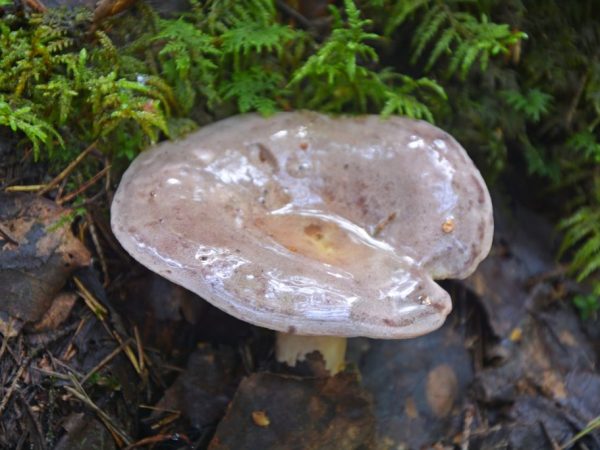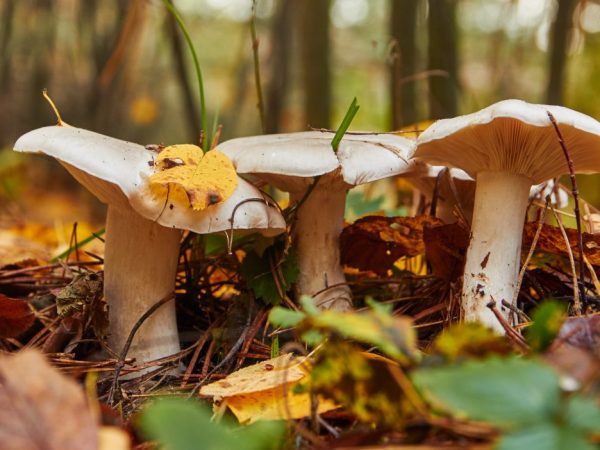Description of the mushroom serushka
The serushka mushroom is one of the most popular among gourmets and amateurs. It is common in birch groves and in the north, including Siberia. Because of the caustic milky juice in the composition of the serushka, it is considered conditionally edible.

Description of the mushroom serushka
Description
The mushroom has a rich gray cap, which is reflected in its name. His other "names":
- seruha;
- seryanka;
- the nest box is gray;
- gray milky (gray-lilac);
- backrest;
- plantain;
- traveler.
This type of delicious mushroom belongs to the genus Millechnik of the russula family. Belonging to the genus Mlechnik indicates a specific feature - the presence of milky sap. The fungus is found in mixed, birch and aspen forests, often near roads and paths in the forest, singly or in small groups.
According to the species description of the gray hat, the color of its cap varies from pink and violet-gray to brown-lead. In all cases, it contains concentric zones noticeable in color (darker). In the process of growth, the cap is initially convex over the entire area. In a mature specimen, it has the shape of a funnel with a smooth tubercle in the middle. The edges are uneven and drooping. The row reaches 10 cm in diameter.
Irina Selyutina (Biologist):
A plump little leg is inherent in the little serushka, which you cannot always see because of the rather large hat. The fungus grows in height by no more than 8 cm, but the cap in a rainy summer can reach a diameter of 20 cm. Unlike most mushrooms, the gray grits do not damage worms, and even if this happens, the cap remains intact - only the bottom of the leg suffers ... Cylinder-shaped leg with grooves along its entire length. It is because of the hollow legs of mature specimens that mushroom pickers nicknamed the gray "duplyanka".
The composition of the milk juice contains an antibiotic that is able to fight Staphylococcus aureus and some other types of pathogenic bacteria.
Other features of the appearance of the mushroom:
- The plates of the hymenophore are pale, yellowish in color. Rarely located. At first glance, it immediately becomes noticeable that they have grown to the leg and it seems as if they are descending. In appearance, the plates can be sinuous.
- Spores are usually yellowish in color.
- The leg is hollow, but only in mature seryanka. The shape of the leg of a growing representative of the species may be slightly swollen or, conversely, narrowed. Usually its thickness does not exceed 2 cm, and its length is 8 cm.
- The dense white flesh has a fruity smell.
- When cut or broken, a very caustic white milky sap is released, which does not change color upon contact with air. Interestingly, at the site of damage, the juice forms non-hardening droplets.
Edibility
Mushrooms of this type are conditionally edible and belong to the 3rd food category, therefore, they should be soaked for several days before use. This will relieve them of the bitter-pungent taste and make them suitable for salting. For these purposes, young chariots with a hat no more than 7 cm in diameter are best suited.
Before salting, you need to remove the skin from the caps of the serushki. After that, the mushrooms are washed several times.Initially, they are soaked in cold water for 2 hours, and then sent to hot salted water for 15-20 minutes. It is recommended to soak very heavily contaminated mushrooms for at least 2 days. Cereals are salted in 2 ways: cold and hot, however, experienced mushroom pickers claim that salted grains are tastier, salted in the first way.
However, mushroom pickers advise to taste seryanka when soaking - sometimes the bitterness disappears after 1-2 changes of water. Therefore, preprocessing can be stopped. Mushroom pickers say that more bitterness is found in mushrooms that grow in coniferous forests, but in mushrooms collected in deciduous forests, it is less.
It is also possible to add serushki to the first courses during cooking. It is stewed, fried, while it goes well with other mushrooms, for example, in pickled form.
Spread

The row can be found only in autumn
Plantain grows on loamy and sandy loam areas, wet, but well lit. Usually, these mushrooms grow in groups, often inhabiting lowland (and not only) birch forests. They are found in areas where melt water stays for a long time, on ordinary forest edges and glades. Serushka occurs from summer to October inclusive.
Beneficial features
In the Middle Ages, the stomach and related diseases were treated with a serush. It was even included in medicines for cholera and consumption (tuberculosis). The mushroom contains many vitamins and trace elements in suitable proportions. They are considered unique.
Seryanka is suitable for dietary nutrition, since it is surprisingly well absorbed by the body, and has the right effect on it. It is a wonderful immune stimulant and gastrointestinal tract support.
The calorie content of a gray-grain grinder per 100 g of mass is 18.5 kcal.
Energy value is (per 100 g):
- proteins: 1.8 g;
- fat: 0.8 g;
- carbohydrates: 1.1 g.
The vitamin composition per 100 g of the product is presented:
- choline - 17.3 mg;
- betaine - 9.4 mg;
- nicotinic acid - 3.607 mg;
- vitamin C - 2.1 mg;
- pantothenic acid - 1.497 mg;
- riboflavin - 0.402 mg;
- vitamin b6 - 0.104 mg;
- thiamine - 0.081 mg;
- folic acid - 17 mcg;
- vitamin K1 - 1 mcg;
- group D - 0.4 μg;
- alpha-tocopherol (E) - 0.01 mg;
- vitamin b12 - 0.04 mcg.
Mineral composition (per 100 g) also speaks volumes:
- potassium - 318 mg;
- phosphorus - 86 mg;
- selenium - 9.3 mg;
- magnesium - 9 mg;
- calcium - 3 mg;
- zinc - 0.52 mg;
- iron - 0.5 mg;
- copper - 0.318 mg;
- manganese - 0.047 mg.
This mushroom has a positive effect on the brain, blood vessels and even the excretion of salts from the body.
Indications and contraindications for use
According to the description, green tea is not harmful to humans, so there are no strict contraindications. In this case, soaking in water is extremely important to get rid of the unpleasant aftertaste.
Serushki are edible even raw, but it is imperative to know when to stop, because overeating will have a bad effect on digestion, and in case of gastrointestinal diseases, mushrooms are best consumed in minimal doses.
Already from September, spores can be found near mushrooms on the surface of the soil or vegetation - they look like white powder. This signals the "maturity" of the mushroom, its reaching age, when it is no longer worth collecting, because it has fulfilled its mission and now the fruiting body will begin to collapse.
Lilac milky contains many polysaccharides that help to strengthen the immune system, so it is often used in the manufacture of tinctures, decoctions and even ointments. All this helps in the treatment of the skin and internal organs of a person.
Serushki have an excellent antiparasitic effect and are able to cope with many types of worms.
Conclusion
When picking mushrooms, it is always worth remembering: they are like a sponge that absorbs everything around it. This is extremely dangerous due to the difficult environmental situation in most regions of Russia, therefore, it is better to pick mushrooms in ecologically clean areas. Be sure to pay attention to the places where mushrooms are collected, giving preference to environmentally friendly ones.If you respect the proportions and have a sense of proportion, the grill will be an excellent addition to the diet.


